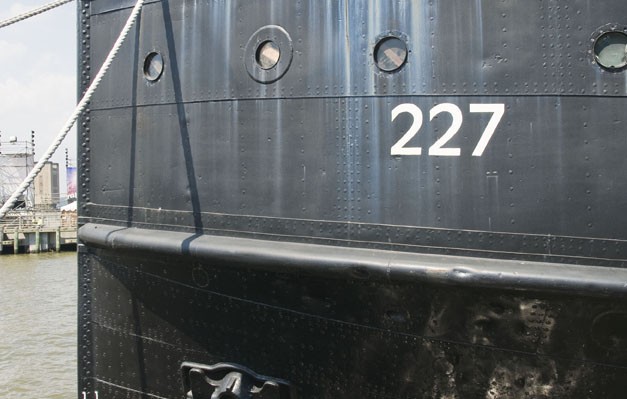
Interview with Peter Brock
Pooja Kakar: What are you planning to present for “DiA on the LILAC”?
Peter Brock: I plan to hang a single piece from an ongoing series entitled “water paintings.” In this photograph, a gently curving brushstroke of water bisects a diagonal shadow. This event occurs on an off-white interior wall, with morning light raking in from the side. The angle of the light accentuates the spongy dimpling of the paint as it was rolled onto sheetrock. Two beads of water hang precariously at the end of the stroke, threatening to disrupt the calm gesture.
PK: How are you planning on utilizing the unique space on the LILAC to showcase your work/create an experience for the viewer?
PB: The constituent parts of this work (water, paint, wall, sun, shadow) exist onboard the LILAC. By placing this work in the officer’s cabin, I hope to draw attention to the shadows in the room. How will the angle of light change the texture of the wall? The enamel paint on the steel walls has resilient sheen, but still reveals subtle undulations of the surface. The water below the LILAC offers buoyancy but threatens to erode the steel structure should the paint fail. I once spent grueling hours chiseling away blisters of rust on the deck of a tugboat, each one the result of a failure in the protective film. I have come to think of paint as a transformative film, including the stains of water on porous surfaces that comprise the “water paintings.” I am curious to see how this transformation fares amidst the painted surfaces of the LILAC. What is the consequence of the failure to transform a surface? Is this a durable transformation?
PK: Some of your recent works includes water and/or pigment on concrete; can you describe the process behind this and how and why you choose your materials? Could you explain your process—from the inception of an idea to its execution in an exhibit, in greater detail?
PB: My process is rooted in day-to-day looking. By this I mean paying close attention to the surfaces of my environment, which is New York most of the year. I come to these surfaces with a background in painting and an inclination to see pictorial depth. Recently I have been experimenting with making painterly marks on urban surfaces using a brush and water. I photograph the process and consider the types of language and transformation that occur. I am excited by the spatial fluctuation that happens when water activates the speckled tones of the sidewalk. The grains of sand and gravel aggregate appear vibrant. These interventions evoke a basic metaphor of painterly space and yet maintain their identity as mundane material.
PK: Can you elaborate on the process and development of making public art projects? The Williamsburg Bridge for instance seemed like a unique collaboration.
PB: The Williamsburg Bridge project involved several collaborators and close to three months of planning. When I moved to New York, I missed seeing the horizon. When I walked over the Williamsburg Bridge for the first time, I became enamored with the vantage point it offered on the city. My installation of colored ovals on the bridge was intended to enliven the space and draw attention to horizon. Although we had no permission or support from the city, the piece has been up for over two years.
PK: What projects are you currently working on?
PB: I am continuing to investigate the minimal transformation of porous surfaces with water, vegetable oil and graphite. I recently spent some time examining how liquid graphite changes the bark of a tree into a rhythmic and textured monochrome. I am also working with video to explore the fleeting quality of these painted water shapes. The heat of the sun works against my desire to articulate a solid shape with clean edges. While photographs provide a sense of satisfaction and accomplishment, the video pieces involve a Sisyphean defeat of form.
Tags: Journal